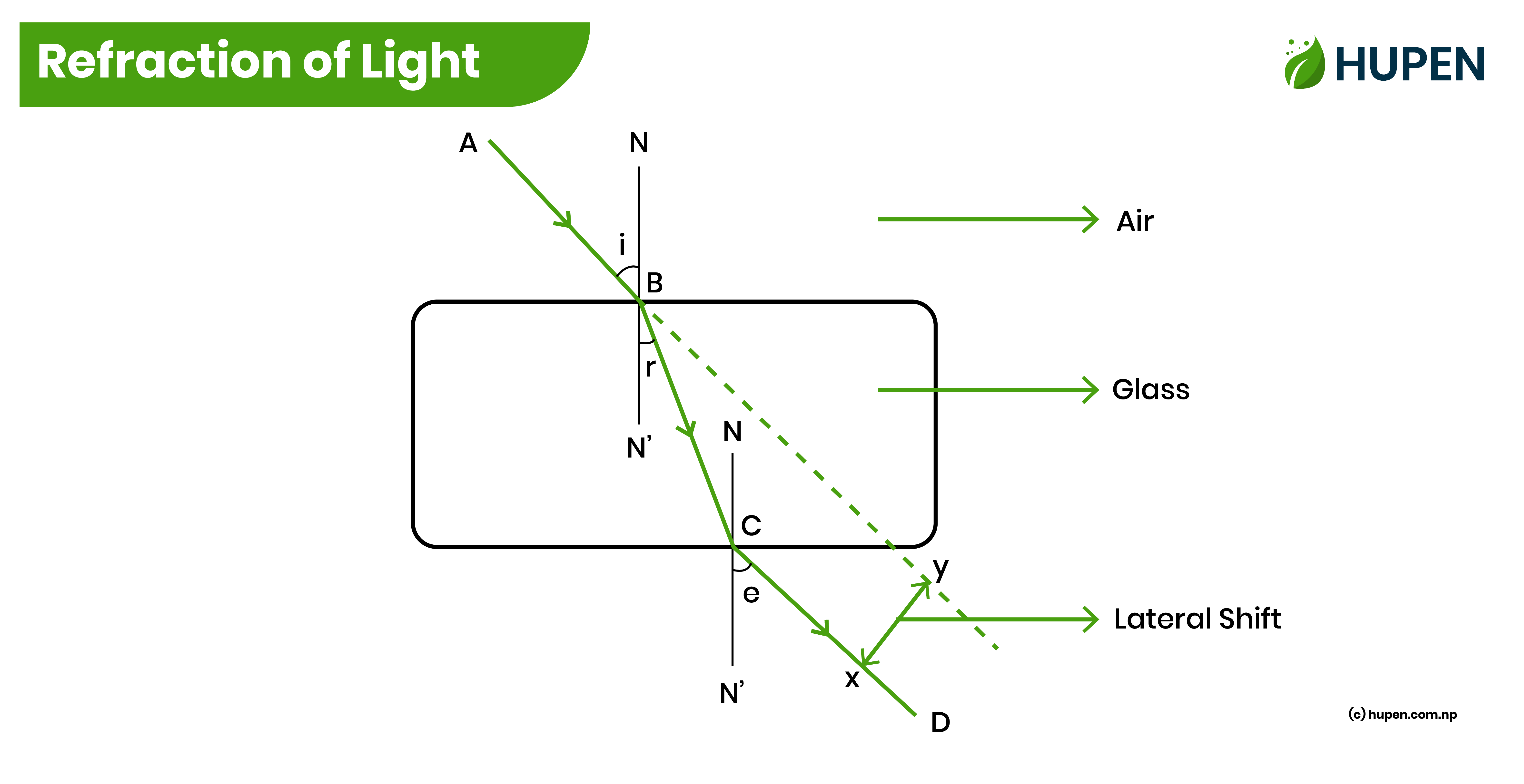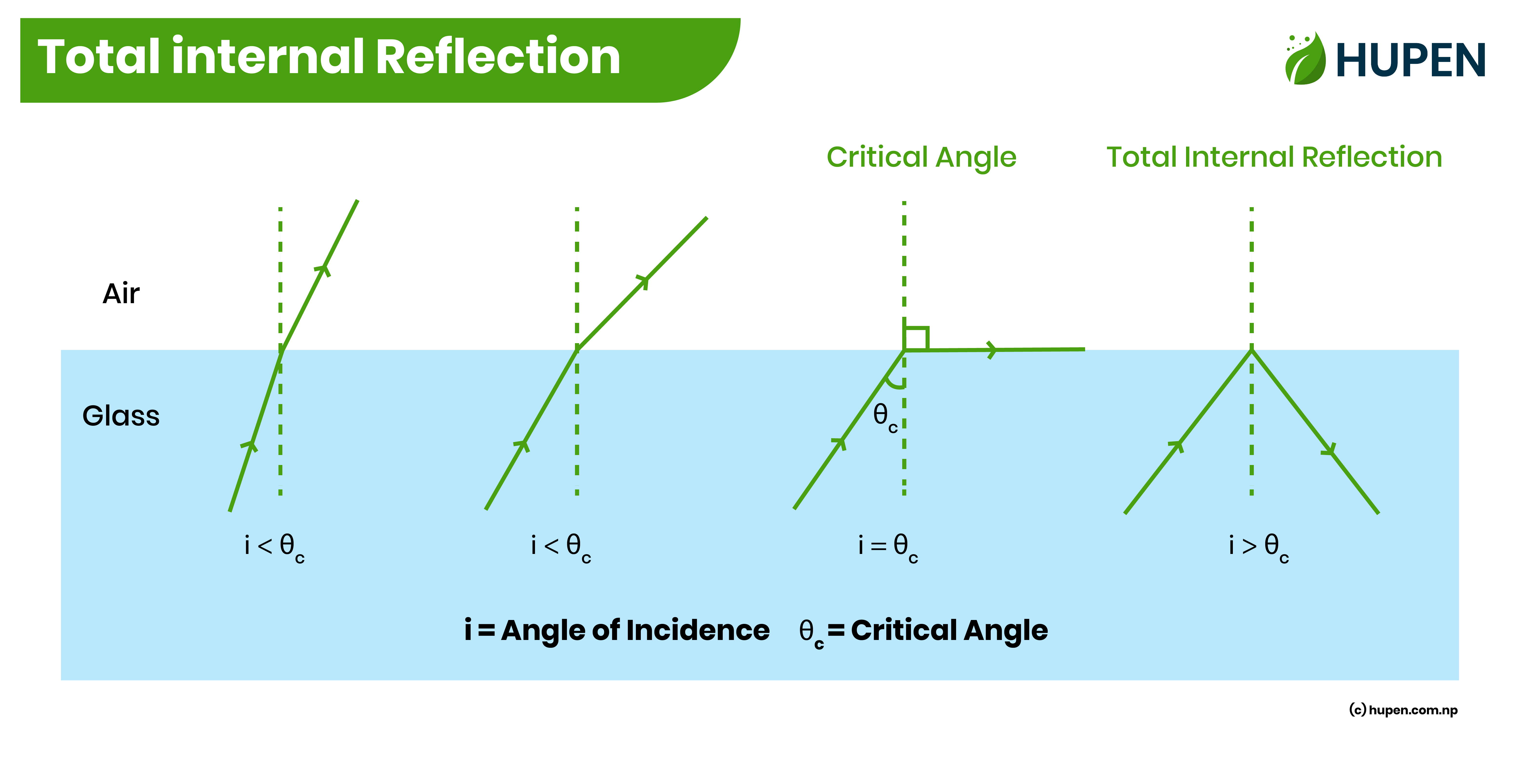
Light
The energy emitted by extremely hot objects in the form of radiation is called Light. Light can travel in a vacuum that is it doesn’t require a medium to travel. Light is energy that helps us see things around us.
Rarer and Denser Medium
In between two given mediums, the medium where the speed of light is relatively greater is called the Rarer Medium.
In between two given mediums, the medium where the speed of light is relatively smaller is called Denser Medium.
Glass and air: Air is a rarer medium and glass is a denser medium
Glass and Water: Water is a rarer medium and glass is a denser medium
Refraction of Light
The phenomenon of bending of light when light travels from one medium to another is called Refraction of Light. The speed of light increases or decreases when it travels between mediums which is the main cause of the refraction of light.

Terminologies Related to Refraction of Light
a. Normal
The perpendicular line on the junction of the mediums is called Normal. In above figure NN’ is Normal.
b. Incident Ray
A ray of light that falls on any surface(medium) is called as an Incident ray. In above figure AB is Incident Ray.
c. Angle of Incidence
The angle made by incident ray with normal is called Angle of Incidence. It is represented by the letter \( \angle \) i. In above figure \( \angle \) ABN is Angle of Incidence.
d. Refracted Ray
A ray of light which is deviated and moves the medium is called a refracted ray. In above figure CD is Refracted Ray.
e. Angle of Refraction
The angle made by a refracted ray with normal is called the angle of Refraction. It is represented by the letter \( \angle \) r. In above figure \( \angle \) CBN’ is Angle of Reflection.
f. Emergent Ray
A ray of light that originates from the surface of the medium is called an emergent ray. In above figure CD is Emergent Ray.
g. Angle of Emergence
The angle made by an emergent ray with normal is called the Angle of Emergence. It is represented by letter \( \angle \) e. In above figure \( \angle \) DCN’ is Angle of Emergence.
h. Lateral Shift
The distance between the extended line of incident ray and emergent ray is called lateral shift. In above figure XY is Normal.
Laws of Refraction of Light
The refraction of light always obeys the laws of refraction of light.
- The incident ray, the refracted ray, and the normal lie in the same place and point.
- For any pair of media, the ratio of the sine of the angle of incidence (sin i) and sine of the angle of refraction (sine r) is a constant. It is also called Snell’s Law.
Total Internal Reflection
The reflection of a light ray into a denser medium when a ray of light traveling from a denser medium to a rarer medium makes an angle of incidence greater than the critical angle for the two media is called total internal reflection of light.
Conditions for Total Internal Reflection
- The ray of light must travel from a denser medium to a rarer medium.
- The angle of incidence must be greater than the critical angle.

Critical Angle
The angle of incidence at which the angle of refraction is 900 when a ray of light travels from a denser medium to a rarer medium is called a critical angle. It is denoted by C. The critical angle of a given pair of media is calculated with the following formula.

Consequences of Total Internal Reflection
- Sparkling Diamond
The critical angle of a Diamond is 24.40, which is very low compared with other materials like glass. The rays of light with an angle of incidence greater than the critical angle will go under multiple total internal reflections within the diamond. Hence due to the total internal reflection, we see the shining diamond.
- Miraj
A mirage forms due to the total internal reflection of light in the atmosphere. When the ground is significantly hotter than the air above it, the lower layers of air become warmer and less dense. As light from distant objects near the ground travels through these layers, it bends upwards because it encounters regions of varying air density. Total internal reflection occurs when the angle of incidence is greater than the critical angle. This phenomenon causes our eyes to perceive an apparent reflection of objects, creating the illusion of water or an oasis on the hot horizon, even though it isn't real.
Applications of Total of Internal Reflection
a. Fiber Optic cable
A fiber optic cable consists of a core made of glass or plastic, surrounded by a cladding layer. The core carries light signals, while the cladding reflects the light into the core through a principle called total internal reflection. This structure allows light to travel within the cable over long distances without significant loss. In telecommunications, fiber optics transmit data as pulses of light, enabling high-speed internet, phone calls, and TV. In the medical field, fiber optics are used for minimally invasive procedures like endoscopy, where tiny cables with a camera deliver images from inside the body, enabling diagnosis and surgery without major incisions.
Share Now
Share to help more learners!

